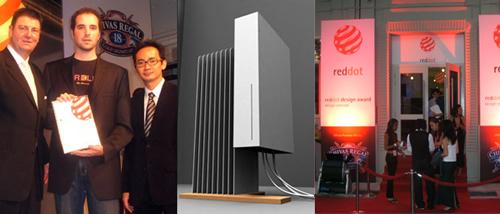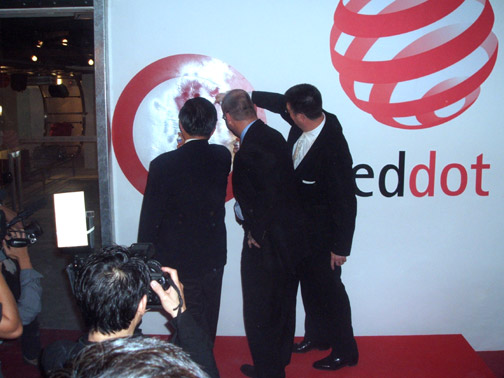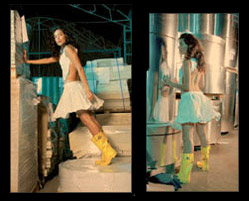Red Dot - Joey Roth- 12.31.05

HAPPY NEW YEAR almost. And thank goodness for an end to 2005… and i welcome 2006 with open arms and a dash of skepticism. But all in all, Notcot has been one of the best things to happen this year, and here’s one of those tasty best for last of the year posts…
Designer Joey Roth (remember his Garden Geta and Shika posts back in the day?) - has done it again with his Totemo, winning the a Red Dot Award in Productivity this year. The Totemo is described as Strip down to cool. The growing importance of silence in computing mirrors a large-scale shift in the way people think about the products they use. The Totemo is designed with recording studios in mind, but is a computer case equally suited for the home or office environment. The omission of LED’s, molded plastic and cooling fans firmly differentiate Totemo from the many computers of today. Its concentration is based on the concept of stripping down the computer case to its bare essentials.
Modest designer that he is, Joey Roth wrote a feature article for Notcot, but just happen to leave out a description of his own project! So take a look at the Totemo on his site, and then read more about his favorite projects and stories from the Red Dot Awards which took place in Singapore recently.
The Red Dot: Design Concept award was created this year to fill in a pretty obvious gap in the industrial design award circuit: an international competition for conceptual yet manufacturable products, open to anyone- students, professionals, and companies. The other Red Dot flavors- product design and communication design- are for designs that have been released to the market and have hopefully made money for somebody. These awards have a long history and are well known by designers and European consumers, although the award has yet to become familiar to consumers in Asian and America.
The ceremony coincided with the opening of a Red Dot museum in the old Singapore
traffic police HQ, a location that I think is more funny/ ironic to someone who has lived in Singapore for a while. This is first ever spin-off of the Red Dot museum and design center in Germany, and when I asked Peter Zec, the president of Red Dot, why he chose Singapore, he mentioned the government’s push to facilitate design and creativity in general within the last three years. Singapore
definitely seemed like the type of place (small enough and organized enough) where some guy in the government could identify a healthy design community as important to the country’s future, and then simply “implement design”.


When I walked by the traffic HQ/ museum earlier that day, drenched in sweat and questioning my aversion to shorts, construction workers were installing windows and what looked to be an electric system, so I wasn’t sure what level of completeness to expect that night. When I arrived there was a red carpet and velvet ropes holding back about three people, but I was there pretty early. The interior was sparse but not unfinished, and there were some extremely comfortable beanbag-like sitting areas in the courtyard. The atmosphere definitely picked up- drinks (all whiskey-based) were passed around as Ministry of Sound DJ’s spun appropriate chill-out music. It became clear pretty quickly that Chivas was a major sponsor, as the only decision one could make booze-wise was 12 years or 18. There were only a few ceiling-mounted AC’s in the entire building, and I began to compete with people for standing space under their vents, although this proved to be a good conversation starter.

Andreas Michaelis, the German ambassador to Singapore, was the first to speak, followed by Chan Soo Sen, the minister for education, trade and industry. They spoke about the growing importance of design and the commoditization of manufacturing, and I learned that the MC was a local TV actress whose name I can’t remember now. After the speeches, we were ushered into a room filled with exhibits of products that had previously won Red Dot’s, and then the current winners were called to the stage while our designs were projected on a number of large screens, restrained house music playing all the while. It was a lot of fun.

Here are some of the winning designs that I liked the best:
Origa Papercut is a line of paper garments that come as patterns on pieces of recycled paper. Revital Kedmi’s design harnesses the participatory element that is so popular in design currently, as the user assembles the paper into wearable clothes. According to Kedmi, Origa Papercut will initially be launched in Japan, where there is already a vibrant paper clothing scene.
P’sof Cake, designed by Jacky Wu of MOD design development Ltd., is one of those elegant, simple ideas that seems obvious in hindsight. It’s a cake cutter that also serves as a cake slice grasping mechanism, and borrows its look from Swiss cheese. Jacky told me that the holes are functional however, and prevent suction from interfering with the cake-cutting process.
Some of my favorite designs came from Lite-On, a company that I know mostly for their computer parts, but is apparently a major incubator for conceptual design in Asia. These Smart Labels, designed by Chih-Kang Chen of Lite-On, are printed with ink that oxidates over time, so that consumers can see at a glance how fresh the product is and how much it costs. I could also see this used on club or event fliers, so that the message changes as the date of the event draws closer, or maybe even on some business cards or album artwork.
Another Lite-On design that I really liked was the LBS, or Library Book Scanner. As someone who’s currently working on a thesis that makes reference to a lot of visual information found only in huge, unwieldy art books, this Frank Guo design would be invaluable.
Finally, these boots by Sigalit Ouriel immediately caught my eye. Appropriatley called Down to Earth, these boots are designed to facilitate working in a kneeling position. The backs are cushioned and the sole is rigid enough to support the user’s weight on the flat toe. When I first saw these, I thought they had won because of their look alone, and was extremely impressed when I saw the engineering and human factors research that must have gone into them.
These picks are only a few of the winners- to see the rest, visit the Red Dot winner’s portfolio.
Joey Roth is currently a senior at Swarthmore College majoring in Industrial Design Theory. His silent computer chassis, called Totemo, won the Red Dot for Conceptual Design, for which he attended the award ceremony in Singapore.









